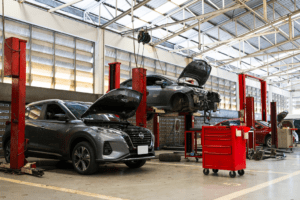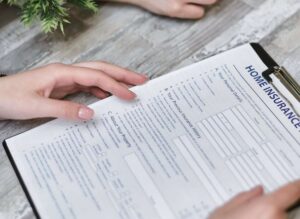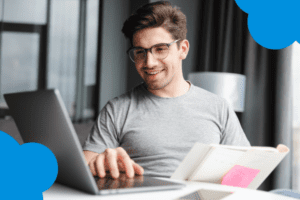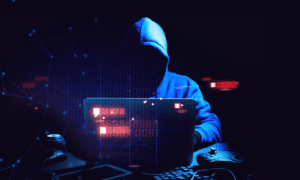2022 Ford F-150 Lightning First Drive Review: Worth the wait
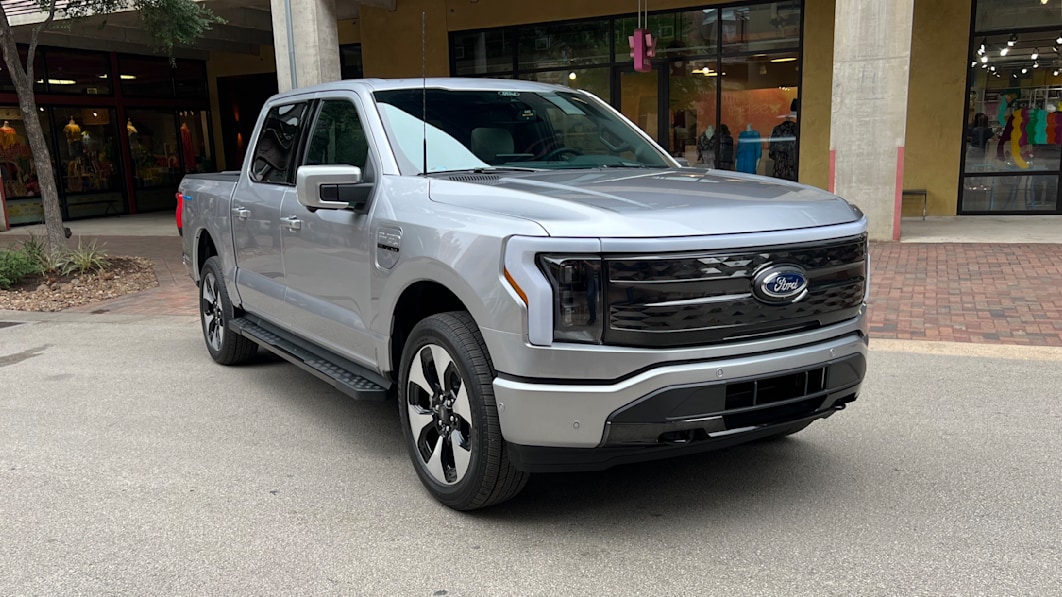
SAN ANTONIO — The 2022 Ford F-150 Lightning had already proven to be a success before we even had a chance to drive the thing. The order books already closed for its first model year, so for 2022 at least, this review is basically for all those folks who are already getting one. And it’s easy to see why they jumped at the chance to stand in line. The formula consists of taking the best-selling vehicle in America — the F-Series pickup — and giving it an all-electric powertrain. If that weren’t enough, Ford also made it the most powerful F-150 and the quickest to accelerate, and packed it unique benefits like a front trunk and means to power your entire house in the event of an outage. The question is, then, does that formula translate into an electric truck that’s as good as it sounds? Ford invited us to heart of truck country, San Antonio, Texas, to find out.
The F-150 Lightning has two powertrain options, but no matter which you pick, you get two electric motors — one front, one rear — providing all-wheel drive. The Standard Range version features a 98-kilowatt-hour battery good for 230 miles of driving range between charges. This powertrain provides 452 horsepower and 775 pound-feet of torque. Ford claims this will do the 0-60 sprint in 5 seconds.
A 131-kWh Extended Range Battery is optional on the fleet version of the Pro trim, the consumer versions of the XLT and Lariat, and standard on the range-topping Platinum. This provides a driving range of 320 miles in Pro, XLT and Lariat, and 300 miles in the Platinum. Choosing this battery also ups the output from the electric motors to 580 hp, maintaining the same 775 lb-ft of torque. This shrinks the 0-60 time to the mid-4-second range.
All trim levels have a few standard features in common. The only Lightning configuration is a SuperCrew cab with a 5.5-foot bed, 4×4 powertrain, and an electronic locking rear differential borrowed from the regular F-150. Each has at least eight 120-volt outlets spread throughout truck, a 12-inch digital instrument panel and a 20-foot mobile charging cable capable of both Level 1 (120 volts) and Level 2 (240 volts, 30 amps using a NEMA 14-50 plug). There’s plenty of shared standard equipment as well, including the Ford Co-Pilot 360 suite of driver assistance tech, but there’s ultimately so much to tell you about the various trim levels, that we thought it was better to break it down in a separate article here.
Our first driving stint in the F-150 Lightning took place on public roads in and around San Antonio in the Platinum trim with the Extended Range battery. After our first ride in the Lighting prototype last September, Autoblog Road Test Editor Zac Palmer noted that “Any F-150 owner could hop into the Lightning and instantly feel at home.” While he was speaking about the experience as a passenger, it holds true from the driver’s seat of the production truck as well. The 15.5-inch infotainment screen shared with the Mustang Mach-E is the interior’s headlining feature (and we generally like it), but the rest of the interior is very much common with other F-150s. That includes the fold-down shifter and deployable workspace borrowed from the regular F-150 that’s perfect for when you need to stop to take some notes (or enjoy a tidy meal) inside your truck.
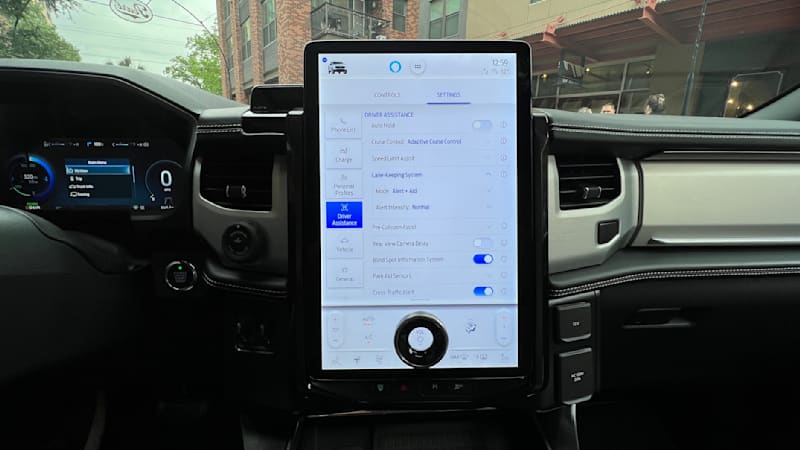

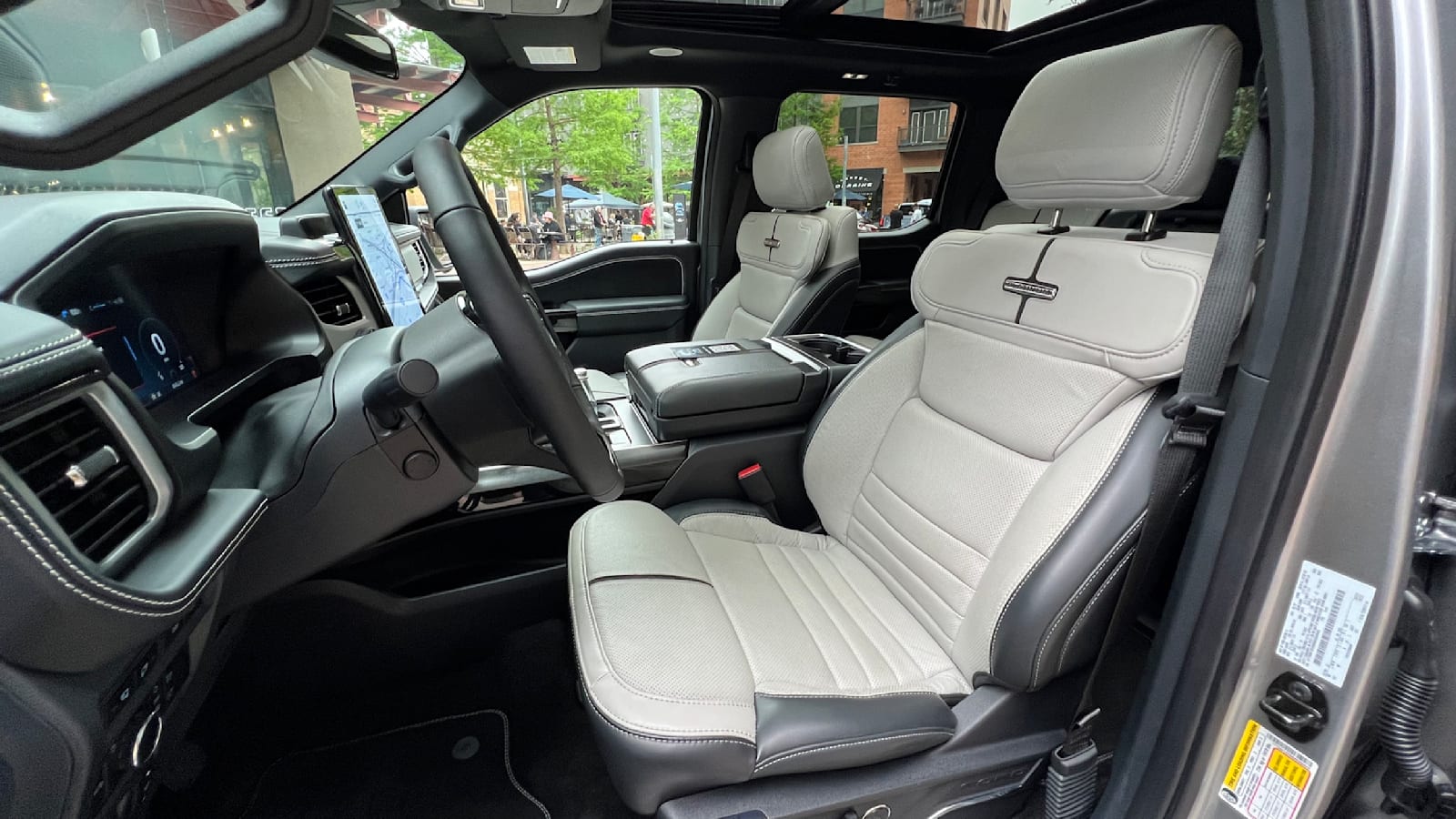

Firing it up, we headed out from downtown San Antonio, creeping silently through the streets. There, the driving felt similar to other electric vehicles — instant, smooth acceleration and supremely quiet operation — but, just, bigger. On the expressway, the Lightning’s powertrain really began to set itself apart from the F-150s we’re used to. Despite its size and weight, this pickup can hustle. It gets up to speed in what feels like an instant, making merging easy as you just pick your gap and seemingly teleport into it. The motors are so potent that there was never a situation during our drive when we actually needed to put the pedal to the floor.
The electric motors aren’t the only revolutionary thing about this F-150, though. It is the only full-size truck to come equipped with an independent rear suspension rather than the usual solid rear axle. It also has coil springs, which is something . This packaging, Ford says, was to better accommodate the battery, as well as the full-size spare tire below the bed. That said, the Lightning still felt like any other F-150 going down the road. It still exhibited a truck-like ride, though a premium one. It would trundle over imperfections with a cushy rebound, more of a soft bounce than a crashy jolt. We didn’t notice much vibration through the frame structure either, perhaps thanks to the high-strength steel frame encasing the rigid battery pack, with a suspension designed to handle the extra weight of it all.
After a couple dozen miles of highway driving and safe, uneventful BlueCruising (see our separate review of the semi-autonomous driving system coming soon), we made our way onto some more meandering rural highways, where the steering wheel would get some exercise. The steering felt direct, but electronic and artificial. There wasn’t a lot of play on-center, and the weighty feeling builds quickly when you dial in more angle. It’s able to hustle through the corners, building lateral g forces without an excessive amount of lean, though we were still pulled to the sides of the wide seats of the Platinum. We later found the softer seats in the lesser trims held us in place better, but did miss the fancier thrones’ massaging capability.
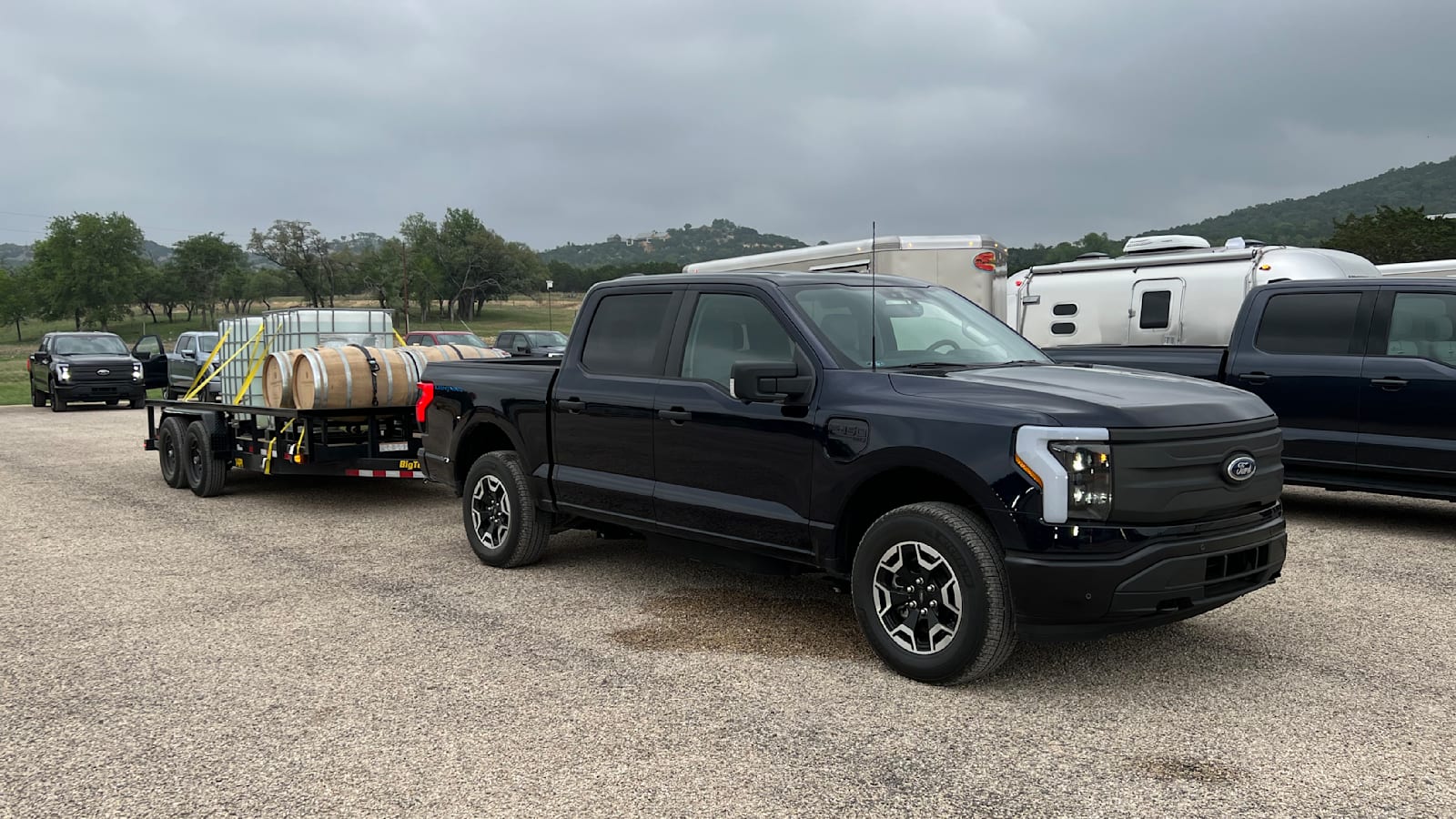


The F-150 Lightning, depending on trim, and options, can tow up to 10,000 pounds; specifically, the Pro, XLT and Lariat equipped with the Extended Range battery and the Maximum Trailer Tow Package are rated to tow that limit. We later hopped in a sufficiently equipped Pro model with a 9,500-pound trailer load attached, and headed out for a quick loop. The truck had no problems with that amount of weight. With all that torque and horsepower, we were never lagging to keep up with traffic, and there was no issue merging onto the highway. The front tires would slip a little when given nearly full throttle, but once traction control brought everything into harmony, the Lightning sped away with ease. Like the best trucks for towing, we could almost forget there was anything behind us once underway. We were far more concerned about the size of the trailer than the weight, and made use of the available rear camera feed on that vast infotainment screen to make sure we gave it plenty of room around corners or when passing oncoming trucks on narrow roads.
Next test up, the off-road course. On a loose dirt trail with a big dip, we managed to get a wheel up in the air – the truck hesitated slightly with the locker off, but traction control was able to eventually get us out of the hole. With the diff locked, there was no hesitation at all. We later climbed and descended steep, rock-strewn hills, splashed through deep, muddy water and crossed a rocky creek bed, all with relative ease and comfort.
Throughout it all, we were able to truly appreciate just how well an electric powertrain is suited for off-roading. Since electric motors produce their maximum torque from zero rpm, there’s no need for a low-range transfer case. Or a transmission, for that matter. So with no gears to manage and deep reserves of power, it was simply a game of linear throttle modulation and finding the right path. Just press a little more deeply with your right foot if you need to get going, and ease off when you don’t. It’s almost too easy.
Perhaps the best thing about an electric 4×4 is the quiet. Roll down the windows and you can hear the world around you — trees rustling, birds, the rocks tumbling beneath the tires. In country as beautiful as these hills outside of San Antonio, it’s nice to be able to enjoy it with more of the senses, free from the chug of an engine or the whiff of exhaust.


Of course, there are more benefits to the electric pickup package than just the driving experience. While a front trunk in electric cars and SUVs seems like a waste of space, it’s actually a great addition for a truck. The Lightning’s 14.1-cubic-foot frunk is comparable in volume to a midsize sedan trunk. That should be enough to eliminate the need for a locking bed cover (or just leaving valuables open to the elements and thieves), and keeps the back seat open for a full load of people. Plus, with ProPower Onboard (more on that in a moment) there are also four 120-volt plugs in there, as well as USB and USB-C ports, meaning you can use that frunk space to charge something while driving (like an electric scooter to get you that last mile), or to power tools or appliances at your worksite or tailgate party.
Every Lightning can provide at least 2.4-kW of electrical power through a total of eight 120-volt, three-prong power outlets spread throughout the truck. The available upgraded ProPower Onboard system adds an extra 7.2-kW of juice for a grand total of 9.6-kW and includes four 120-volt plugs in the frunk, four in the bed and one for each row of seating inside. There’s also a 240-volt outlet in the bed for powering bigger tools, or for charging another EV with the mobile charger and an adapter. Basically, it’s an even more robust version of our Autoblog Technology of the Year.
The F-150 Lightning can also provide power to the home with Intelligent Backup Power. Extended Range models come with the 80-amp Ford Charge Station Pro (it costs $1,310 otherwise). Not only can this charge the Lightning at 19.2 kW, it can also draw 9.6 kW from the vehicle into your home, via the Home Integration System ($3,895) provided by Sunrun. In the case of a power outage, you can use the Lightning like a generator to power your whole home. It has enough energy storage to power the average home (using 30 kWh per day) for three days — or up to 10, Ford says, if you conserve energy to only power the really important things. When power is restored, it will automatically begin recharging the pickup. In places with variable energy rates, the system will also be able to charge the truck when energy is cheap, and use that stored energy to power your home when electricity is expensive.
One feature we had seen teased previously, but had forgotten about until we were digging through some of the menu screens, is a small suite of video games you can play while you’re waiting for your truck to charge at a public station, or waiting to pick up a passenger. We toyed around with them a little between driving sessions, and found them to be pleasant time-wasters. Well, Sudoku has always sucked, but we enjoyed the rest, which include games called Blocks, Jigsaw Puzzles, Lane Change, Sketch and Tiles.
For all those folks who could use something to do while waiting around for their reserved F-150 Lightning to be delivered, rest assured that it’ll be well-worth the wait. As suspected, the truck + electric equation is a no-brainer. It is familiar, yet packed with unique innovations and capabilities. It feels no less of an F-150, and in fact, feels like so much more. We just hope the order books for the 2023 model open soon, and that Ford can quickly get its expanded production online. And, of course, after the knockout Mustang Mach-E, the brilliantly economical Maverick and this absolute powerhouse of an F-150 Lightning, we can’t wait to see what Ford comes out with next.
